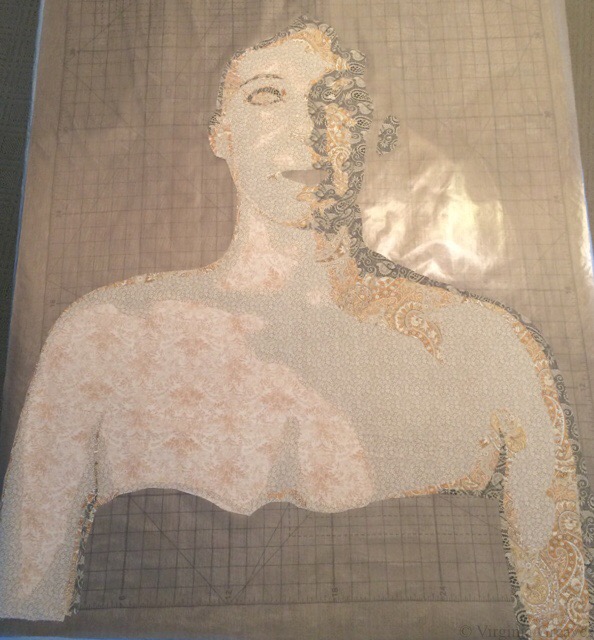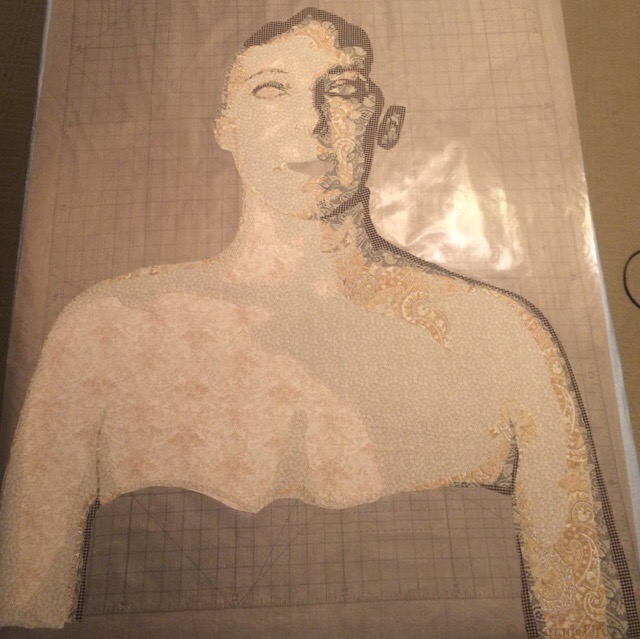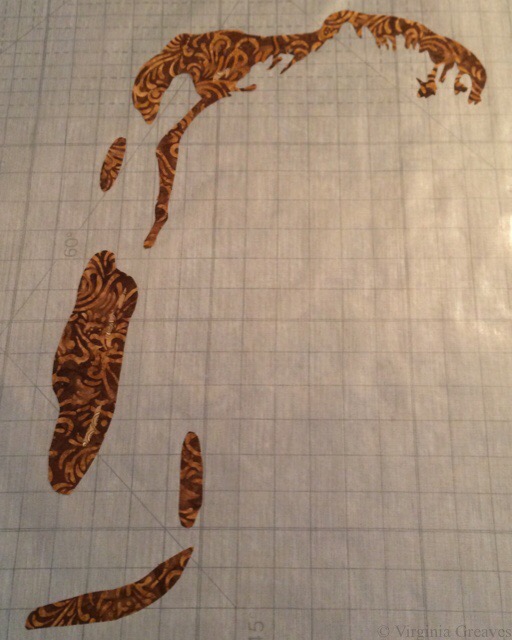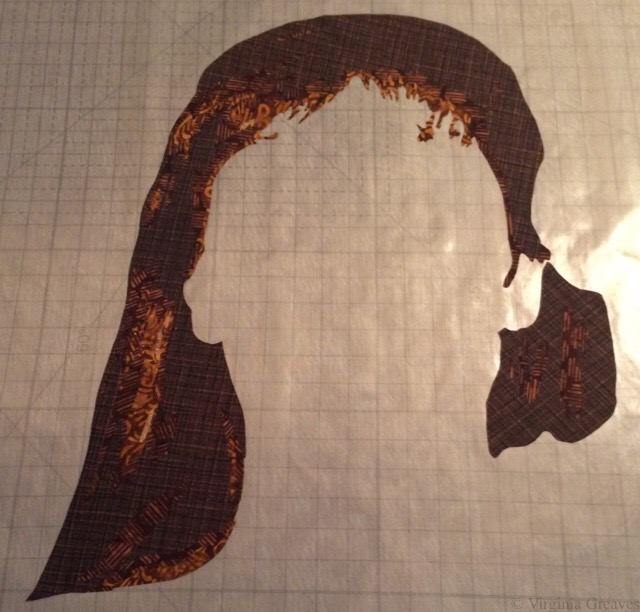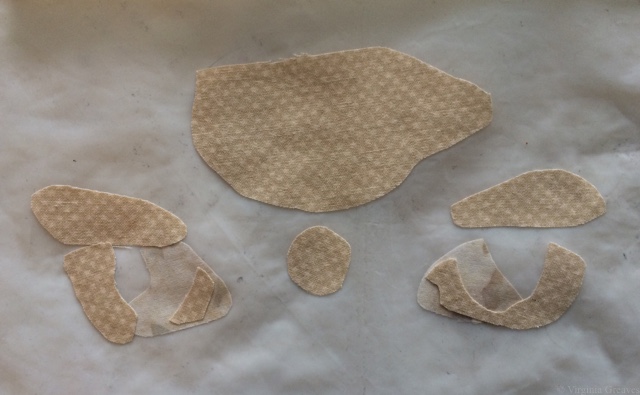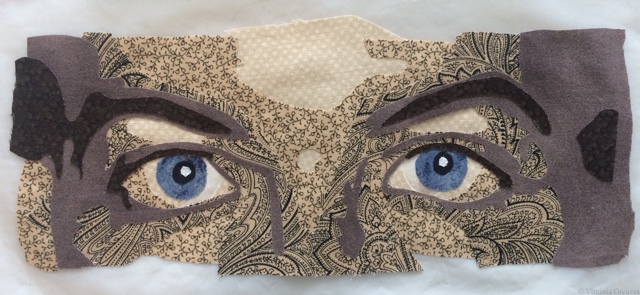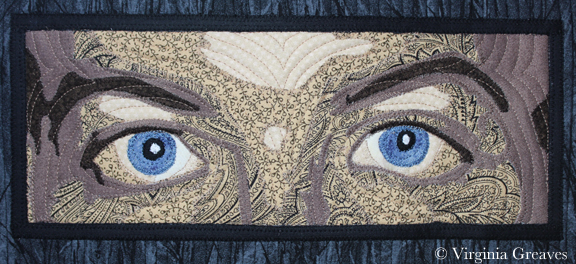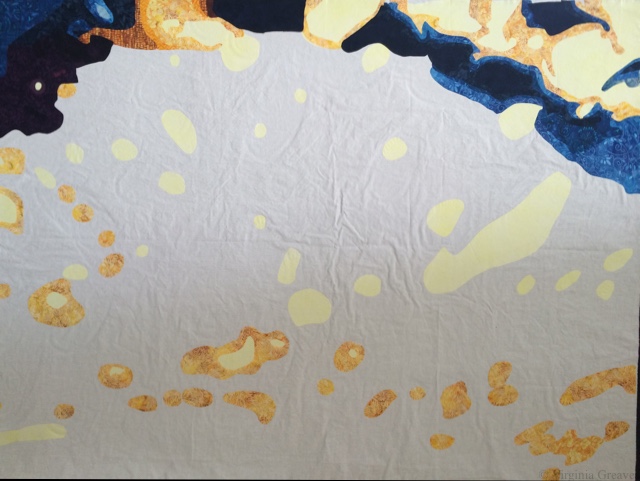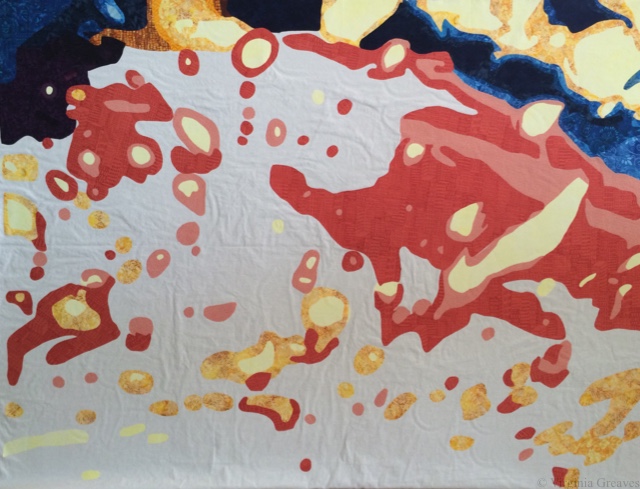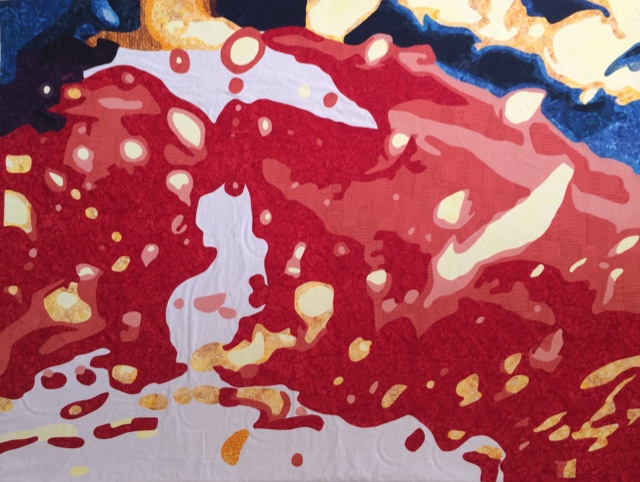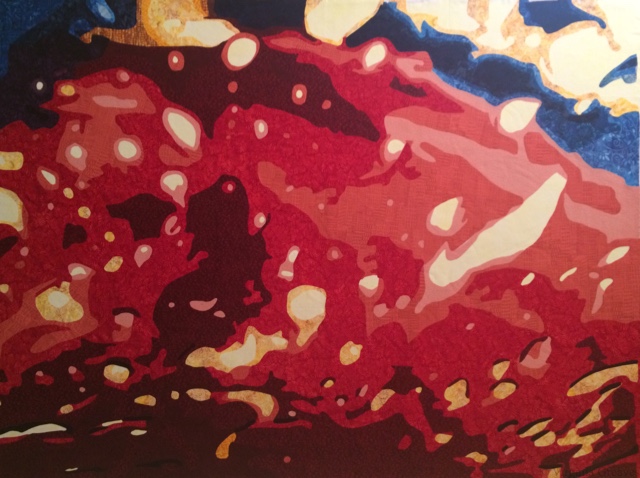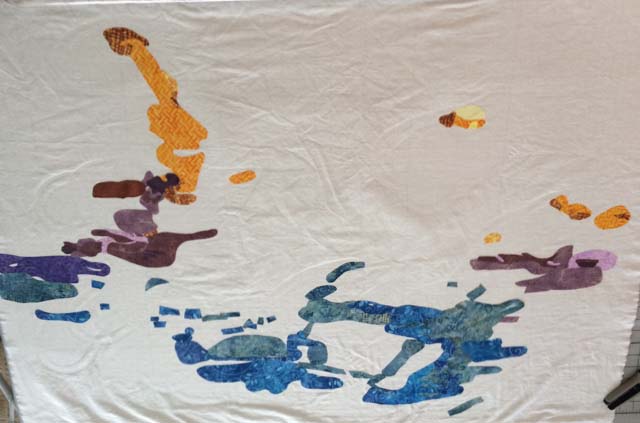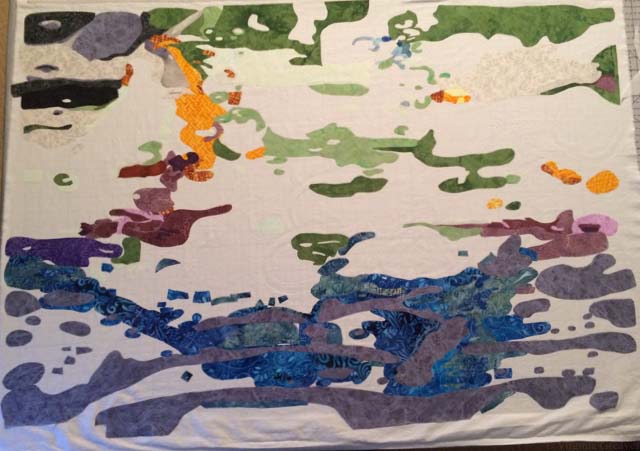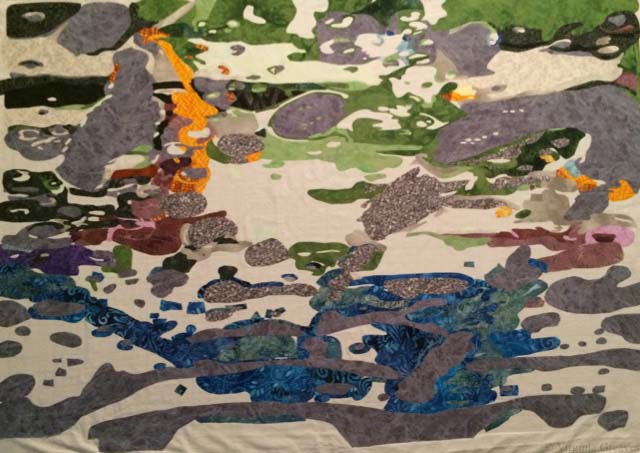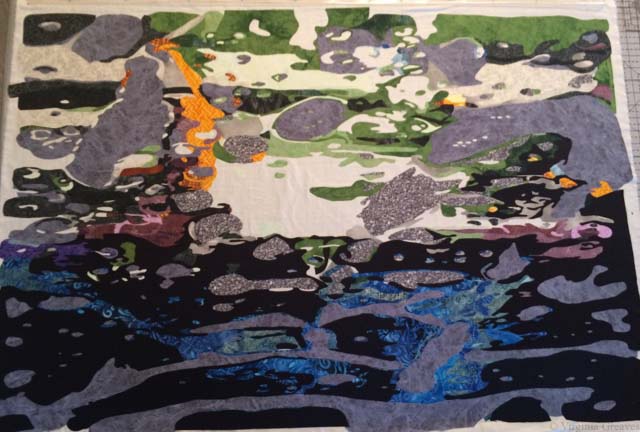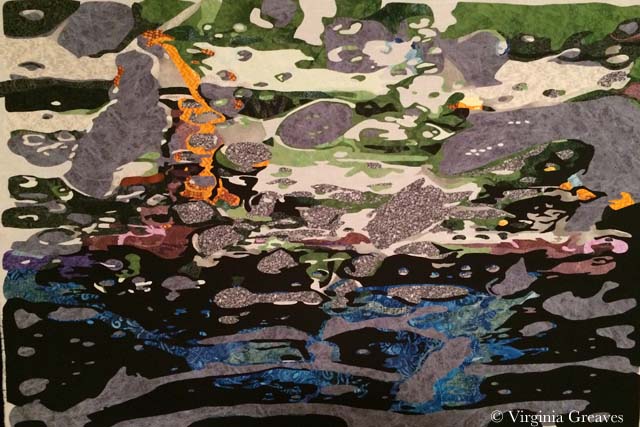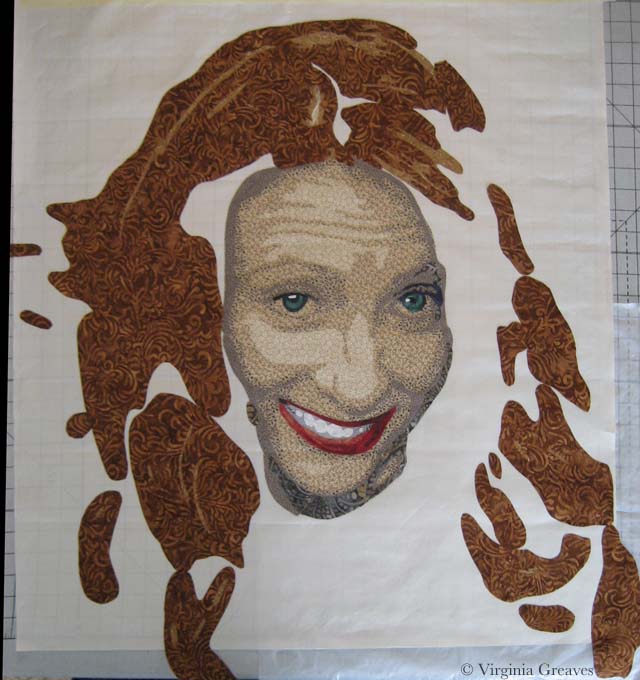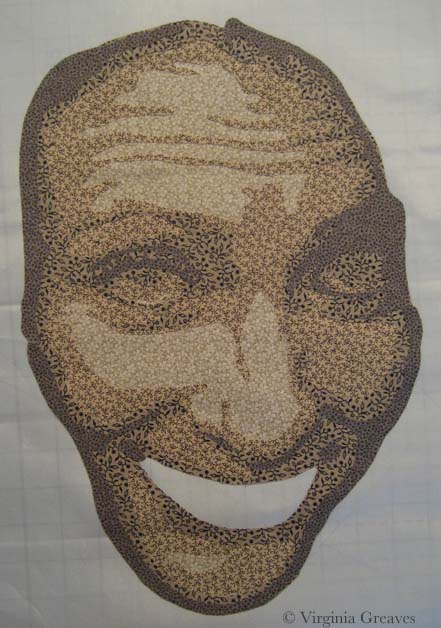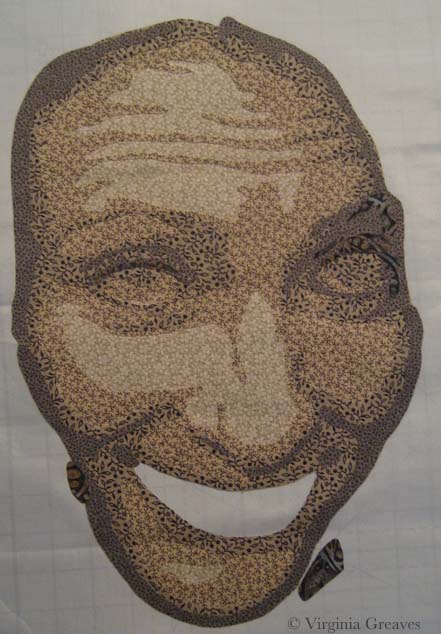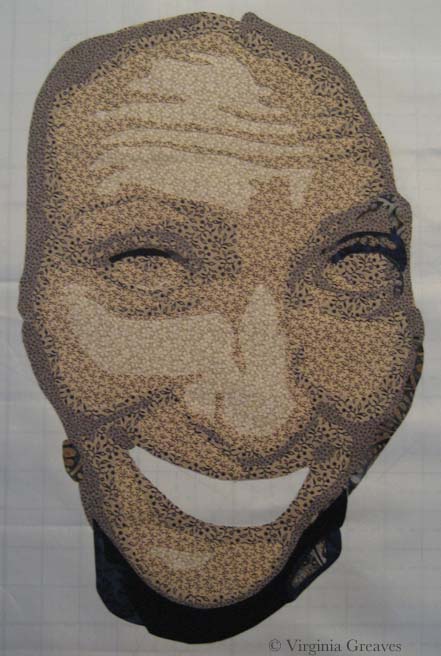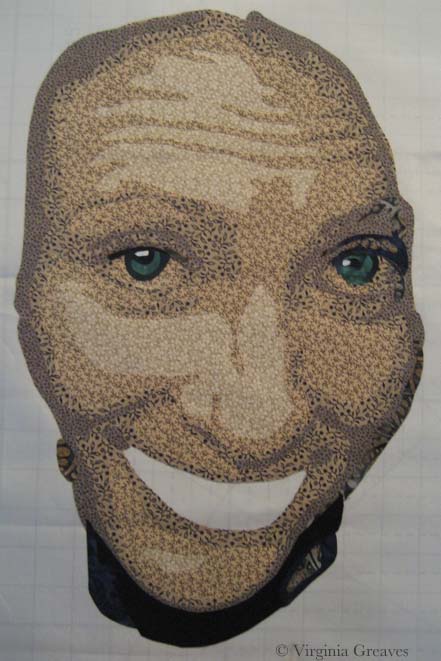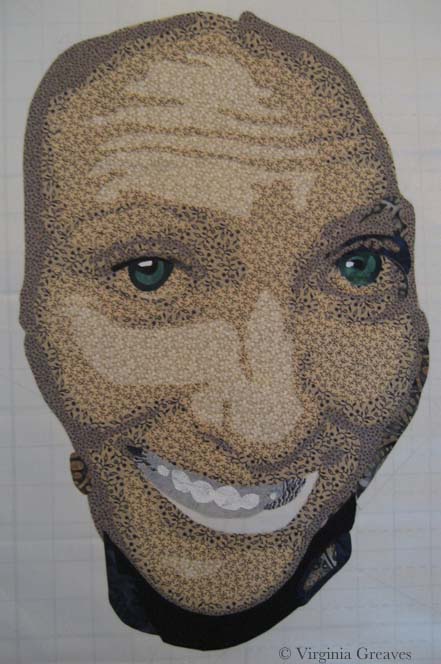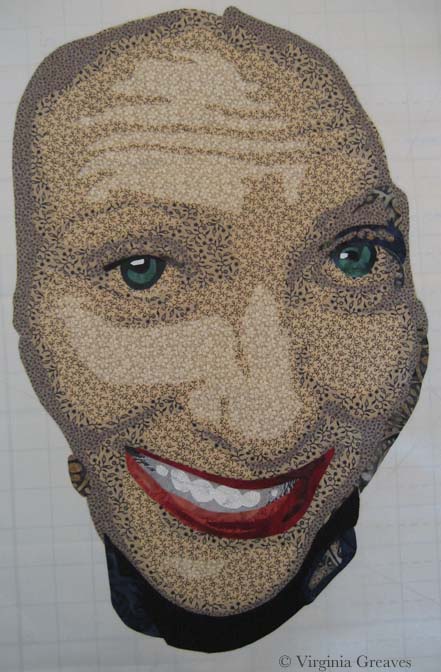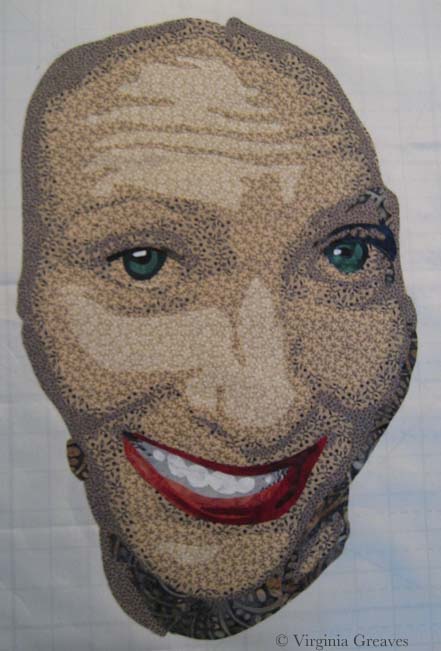Fusing

Brindled
0Although I’ve made many dog portraits, my current pet is brindled, something I despaired that I would never be able to capture in fabric. A brindled animal is typically brown with streaks of black. It’s very distinctive. Given the nature of closed shapes in appliqué, I didn’t think that it was something that I could recreate. However, I was speaking with one of my SAQA mentees recently, and she had tried it in her work with success and encouraged me to do the same. It’s all about the fabric.
So for this piece, I chose a picture I had taken of her with her great big tongue curled up over her nose. It showed a lot of her personality. I searched through my pinks for just the right ones and started there. I could have put the tongue on last but worried about the darker fabrics I would use for her fur showing through, so I started with the tongue.
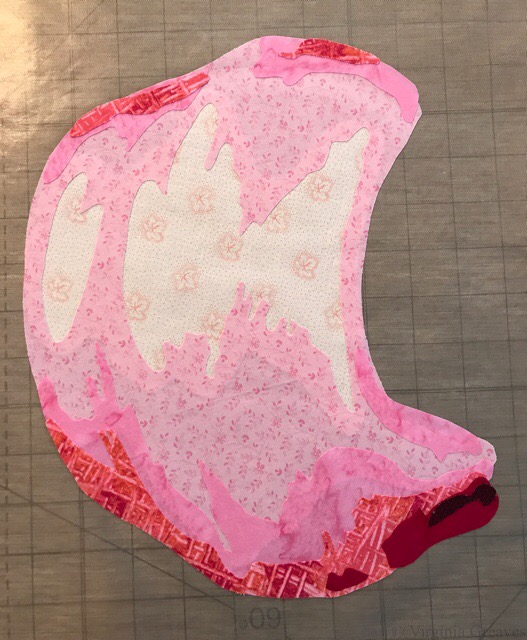
And then after the tongue, I went on to the wet nose.
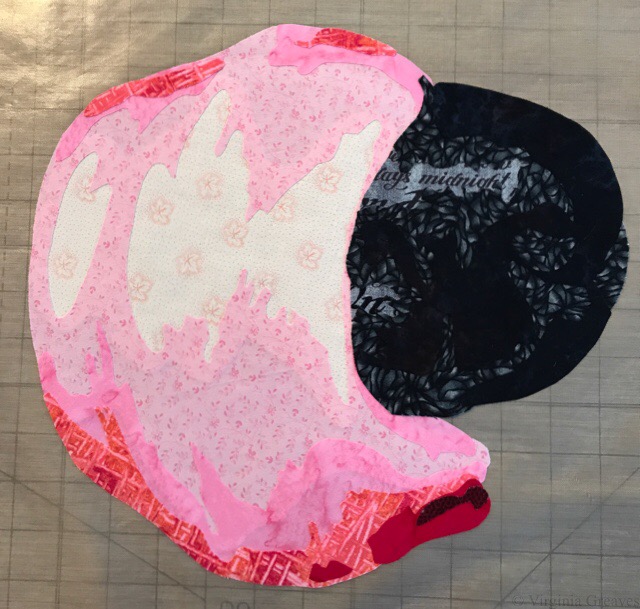
And then the hard part — the fur. I chose highly textured browns. These are the first two values, although there’s only the tiniest amount of the lightest brown up there in the top left-hand corner.
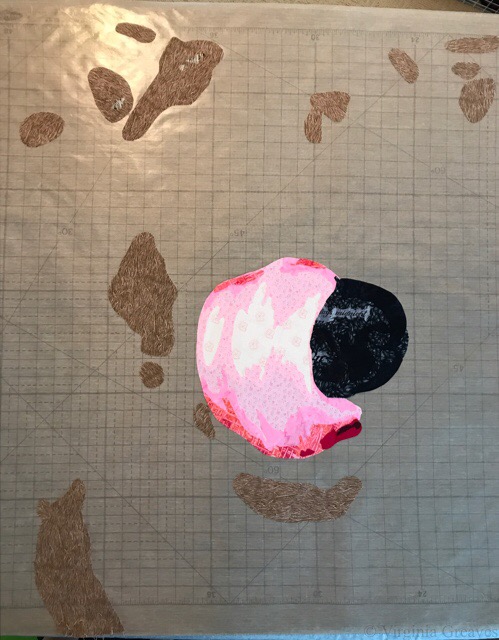
This is the 3rd value — not a very clear pic but probably taken late at night in my studio. Did I mention these are flat on my drafting table and I’m standing above them on a ladder taking the pics?
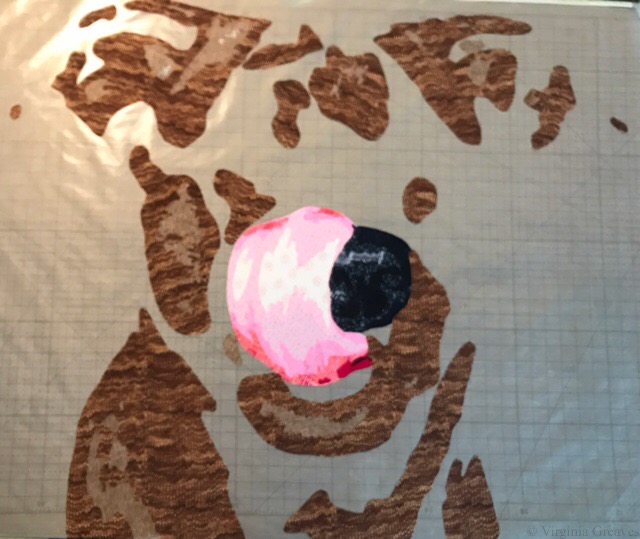
And here, with the next value, you can start to see the magic happen. The textures start to blend together but still maintain their integrity.
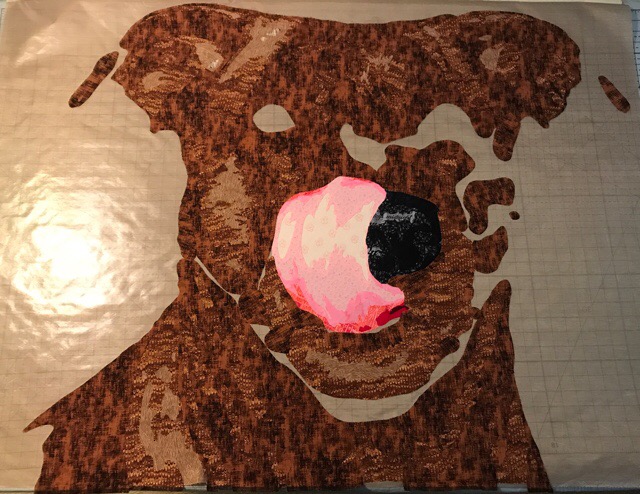
The next value.
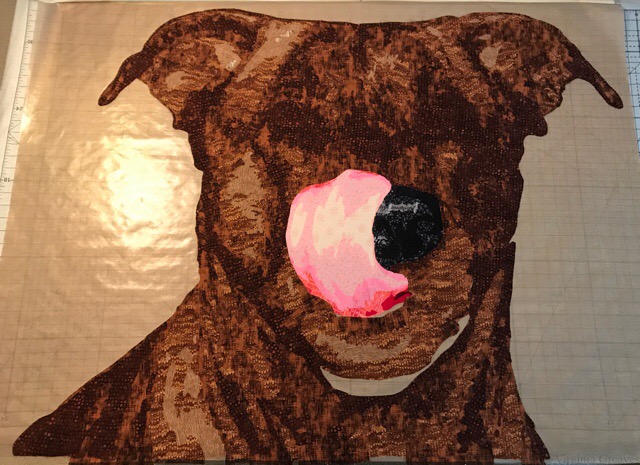
And the darkest value.
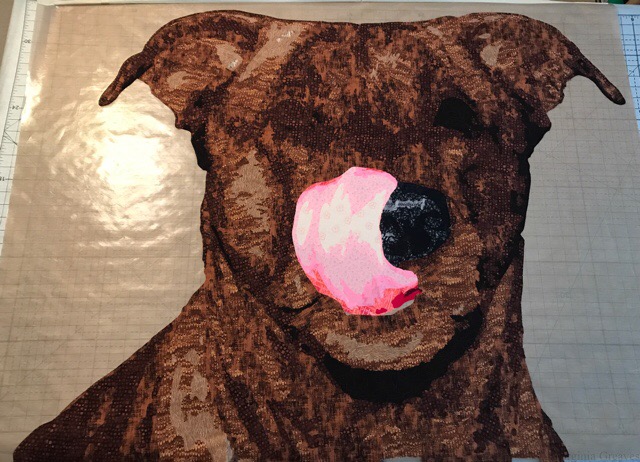
The eyes always make a big difference. It was interesting finding a brown iris color that wouldn’t blend into the fur.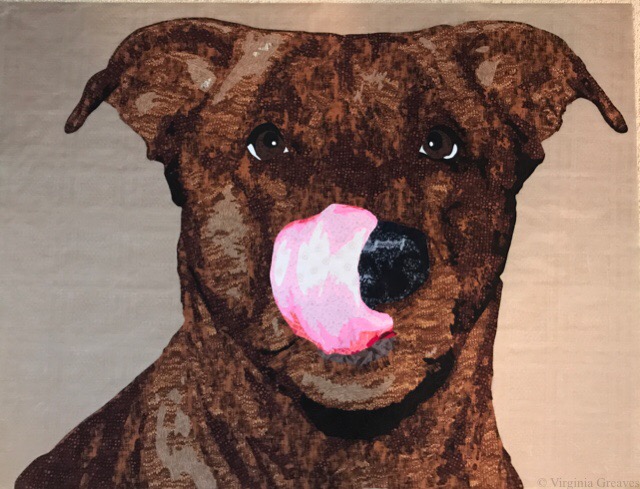
And then this is the background I went with. I cut strips of green and randomly assembled them for the background to give an abstracted look.
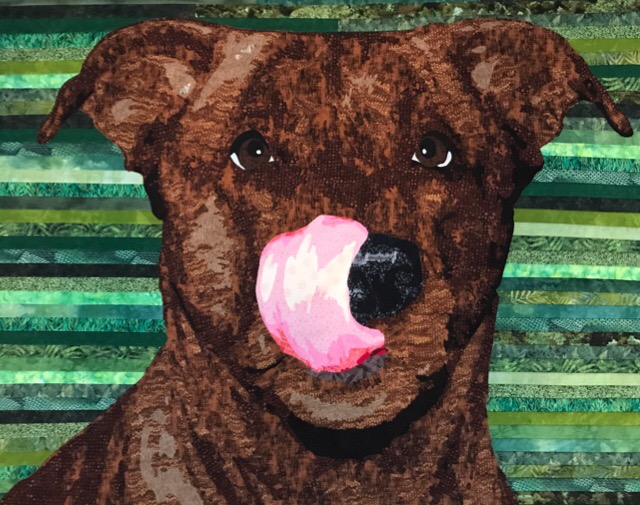
And this is her. This is what she looks like. This is the piece before quilting.
I almost finished this piece in July but a confluence of activity prevented that from happening — so it was finished in early August. And then I was able to then create a piece from beginning to end for the IQA Auction by the end of August. No idea how that happened. I will share pics of that one in another post.
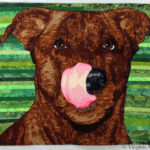 I named it Tasty, and you can find it once quilted and completed on its page here.
I named it Tasty, and you can find it once quilted and completed on its page here.

Making Tattoo
0Woohoo! My first piece in Dinner@8! I know there are a lot of you that can’t comprehend what a big deal this is, but it’s kind of like winning the lottery. It’s a juried invitational show, so I had to apply to be a part of the Dinner@8 group in order to be invited to make a piece for the current year’s show. After I was accepted, I made a piece according to the theme, which this year was Personal Iconography: Graffiti on Cloth.
I haven’t shown the piece in process on the website because that’s a no-no in this show. Virgin rules, except you can post after acceptances go out.
I’ll admit that I was stumped by this year’s theme. My goal, just as I did the Yvonne Porcella piece (Yvonne in the Garden), was to make a piece that was wholly in my style while still working within the framework of the theme, but I knew that doing that with this theme was going to be hard. I knew that I was going to make a portrait of a person, and I spent some time thinking about how tattoos are so personal and would work well within the theme. My daughter has several tattoos, and she spends a lot of time considering the symbology of each piece and finding the right artist before she gets them. I wanted to honor that, but I also knew that finding a female model would be hard. I envisioned a back shot with the main tattoo on the arm. I’m not entirely sure why, but it seems to me to be a deeply personal pose, enough that I didn’t know anyone personally that I felt I could ask. And really, who’s always available? (Me.) Thank goodness I have a remote control for my camera. I set it up in my studio, and by the end of one afternoon, I had a series of shots I could work with to create what I had in my mind.
I started with the shoulders and back first since the hair would drop over the back. I usually start with the face, but in this instance, the shoulders made more sense. This is the first couple of values.
This is the 3rd value. I ran out of the fabric — or rather ran short on it. I knew I needed enough to cut out for the face and decided that I needed to supplement with a fabric that was close. I could use it on the extended arm and the change would be less visible. (This prompted a late night run to JoAnn’s as it was the only thing open at the time, & I was in the creative head space to keep moving forward.)
This is also the point at which I realized I needed to complete the hand along with the arm — and make sure I had enough fabric to do it as well.
And then I added the deeper values, a dark tan and a couple of dark blues — and then the black garment.
And then I started on the face using the same fabric. These are the first two, and you can just see the basic outline.
This is the 3rd value, the one that I ran out of. I’ve had this fabric for a long time, and I’ll have to try to replace it. (Never let anyone tell you that calicos don’t have value. They’re wonderful for faces.)
This is the 4th value. It inadvertently looks a little like horns, but really, that’s just my high forehead that will go under the hair.
The 5th value. You can tell I was working at night in this one.
And then the rest of the darkest values. I leave the main parts of the eyes and the mouth for the end, so at this point, she looks a little bit like a zombie. I did play around with the darks around the eyes a little bit. I naturally have very dark circles around my eyes, but it wasn’t aesthetically pleasing in the piece, so I backed off on the value a little. (This is part of what I call creative license. Do what’s best for the piece and don’t feel tied to exact duplication of the photograph.)
These are the eyes. Not quite right. I almost always freehand cut these nowadays.
And in this one, a darker blue around the rims of the irises and larger pupils. Then I made the teeth (or the suggestion of teeth) and the mouth.
I did go back later and make the eyebrow on the right darker.
I spent quite some time trying to figure out how I would do the tattoos. I wanted them to look like dotwork tattoos, and so screen printing seemed the way to go. I had, years ago, done some screen printing. What could go wrong? I drew the tattoos in my sketchbook, scanned them, skewed them in Photoshop so they would look as if they were on an arm and tilted across the back, and sent them to Fiber on a Whim to be burned to screens. After fusing my figure to a background and appliquéing it in place, I then screened them right on my piece. What was I thinking? The moon is clean but way too light, and the crow is a mess. I even have a paint blotch above the crow’s head.
With the moon, I just grabbed a fabric marker and filled in all of the light spots to clean it up.
The crow was much harder. I think it sat on my ironing board for at least a week while I thought it over. No use crying over split milk. I had leftover fabric, so I made a bunch of screens of the crow until I got a decent screen. I now have mad appreciation for anyone that screen prints, especially to fabric. It’s much harder than it looks to get a clean screen print.
On the finished piece, I cut out the crow and the blotch. I had to pick out appliqué stitches in two places. Those will be covered by the new crow.
Then I took the new crow, cut around the crow shape, and then fused it onto the arm. I also made a patch to fuse onto the area of the blotch that I had to cut out. Then I ran an appliqué stitch around the crow and the patch. I worried that it would be too obvious around the bottom area where the fabric value is darker, but it’s hardly noticeable on the final piece. There’s only about a quarter inch of light fabric around the crow, and it blends with the fabric it’s next to. In the end, it was a good solution to a difficult problem.
As I was making the piece, I thought it would be cool to add graffiti to the background. That’s why I went with a solid blue background. I even studied graffiti shapes and practiced lettering. I made the graffiti, but then I decided it was too much of an in-your-face interpretation of the theme — so I took them off. That was much worse. So I spent time thinking about the background — and about how I approach my work. In the end, I decided that I didn’t want to be safe, and leaving off the graffiti was safe. Keeping them on there gave the piece a vibrancy it didn’t have without them. So I played with their placement and added black outlines to them and some sparkly points.
You can see the final piece on the Tattoo page here.
Tattoo will premiere in the Dinner@8 exhibit at International Quilt Market & Festival in Houston this coming October/November.

The Creative Spirit
2I’ve been hard at work in my studio since my last post, pouring the creative spirit out of me and into my work. And I’ve surprised myself.
If you remember, I had finished the first horse, so I began cutting out the second horse, its companion. This shows the light values of the face.
And then the darker brown values.
And finally the darkest brown values.
Here is the horse head without all of the leather straps, bridle, and silver.
Then I added all of the leather parts around the face.
And finally the leather collar.
Once I added the silver, I put it up on the design wall for a quick picture.
At this point, I put it up next to the other horse to see how it would look. Wow. I loved it on the black, but I always do.
I considered for a while making a pieced background, but I finally decided that the horses themselves are so intricate, a pieced background would only create a distraction. I found a great smudged black that works well.
This is both of the horses appliquéd onto the background. The grays in the background black look lighter than they actually are — my camera phone is limited in its range and chose to highlight all of the silver. The final photographs after quilting will be difficult, but this piece may warrant my first trip to a professional photographer.
For those interested in the process, I abandoned my usual appliqué technique, which is a tight zigzag around all of the rough edges. Even a free-motion straight stitch around the edges as an appliqué technique was difficult as the pieces tried to pull off as I worked on it. The horses were large and complex, and Wonder Under can only hold so well. The silver, especially, didn’t want to adhere. It was always the first appliquéd for each of the horses.
And the end result is more artistic. I’m letting go of the restrictions of the quilt world and embracing the art side. The free motion stitch is much more like drawing on the piece. I still haven’t decided if I’ll add some tulle for added protection to the raw edges.
They each have their own personalities, and I’m surprised at what has crawled out of my brain.
And now I begin thinking about the quilting process. I have a hard time just pinning this on the wall by myself because it’s so large. I tried to take a local long-arm class at the beginning of the month but it was full. The next one is not until the first of December, and I don’t know that I want to wait, but I’m also uncertain about tackling this bear of a piece on my local machine. I do happen to have a Hinterberg frame that I bought years ago — it sits in pieces in the corner. I abandoned it when I realized that my Viking didn’t have enough harp space for me to use it on the frame. But I did get another 4.5 inches, I believe, in harp space when I upgraded to the Janome. It might be worth trying it.

Creating the Canary
8So I haven’t written in a while. I’ve been working on a very personal piece, a self-portrait. I’m a very private person, and I need to remind a few of you of the boundaries here. I write my blog as a teaching tool. This is not intended as a preview into my personal life. If you enjoy reading it, that’s great, but if you know me personally, I don’t intend to answer questions about anything other than process to fellow artists and/or quilters. So please, don’t ask.
My original intention was to make two companion pieces. I intended to make a whole portrait of me (a picture I took of myself with a handy remote control for my camera) and then cut it in half. One piece would be the left half of the realistic me, & the right side would be an artistic interpretation of me inside. The other piece would be the same in reverse. Each piece would focus on two different views of who I am.
But this piece took on a life of its own. It didn’t want to be cut in half, and as I worked on her, she told me what to do.
This is the first flesh value.

This is the second. It’s a full bust and shows my shoulders and a little of my arms.
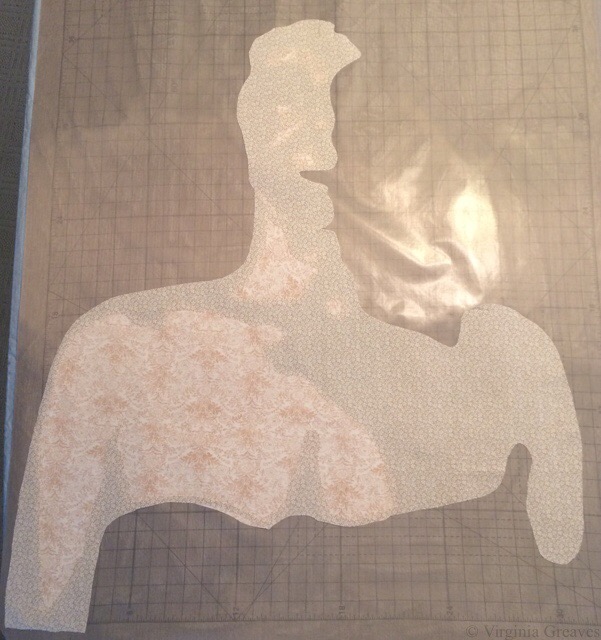
This is the third value. You can begin to see the outline of my face.
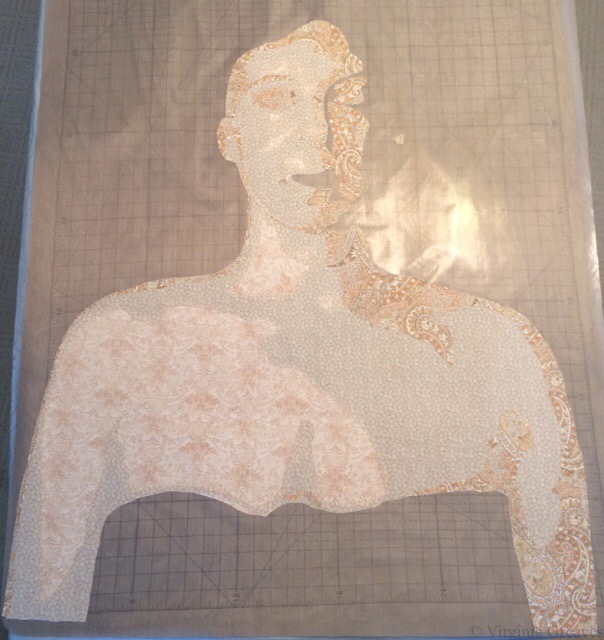
The fourth value shows shadow.
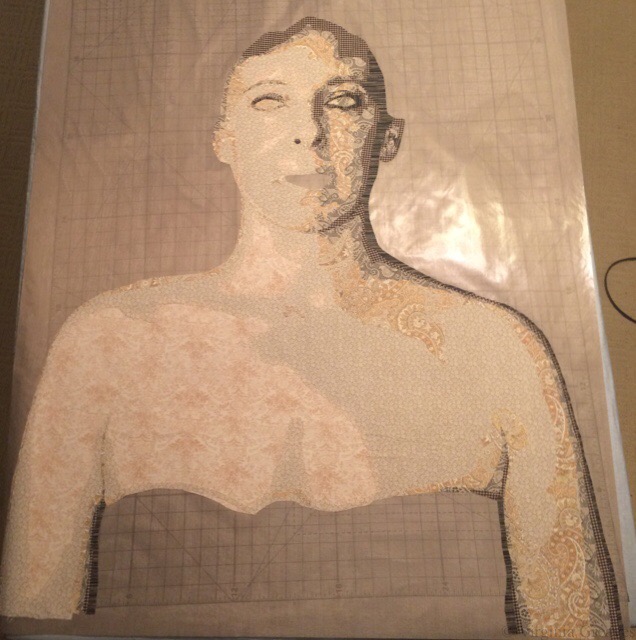
My eyes added. Don’t know why I don’t have a pic with the mouth. I used strong colors on the mouth — very red.

I am, by the way, creating these sections on a pressing sheet. In fact, I bought the Holy Cow pressing sheet just for this project.
This is the beginning of the hair.

At this point, I pinned the sections up on the design board to see if they were working together. I even added a black sarong around my chest (because I’m just not THAT girl).

And then rather than add a solid background, I started cutting out black and white fabrics. Not sure why. I had a lot of them in my stash, small pieces, and I cut them into strips and arranged them by value.
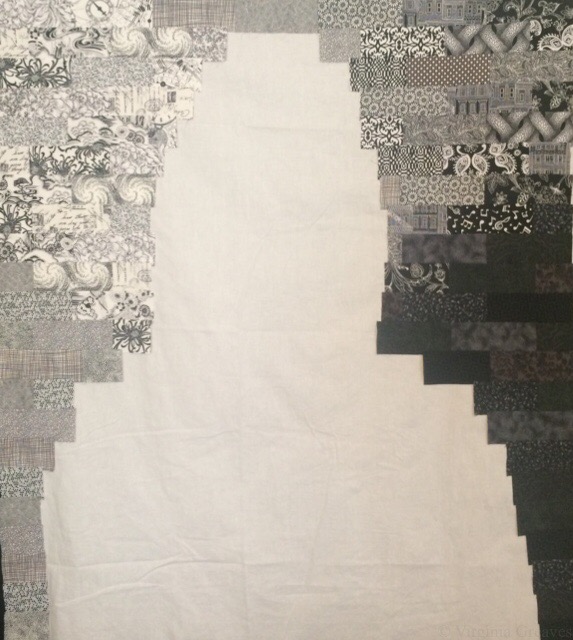
And then I sewed on the flesh section. It was really humbling to see myself bald. I had a friend years ago who shaved her head in solidarity with another woman who lost her hair due to cancer treatments. I had not really thought about it before, but women invest some of their identity in their hair. I don’t know that I could have done the same & shaved it. What would I look like bald? I guess now I have an idea. It’s not as bad as I expected.
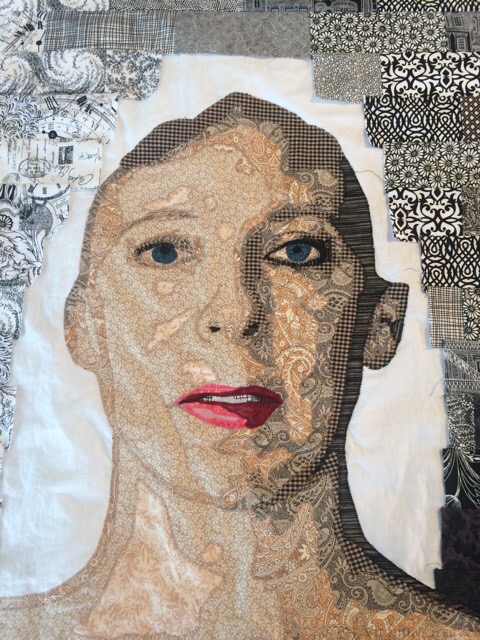
At this point in the appliqué, the interfacing underneath causes some wrinkling on the top. It’s a little unsettling, but when I rip it off the back and iron it, it will be flat again.
And then I pinned this piece on the wall and asked my muse what it needed next.
I considered adding a raven on my shoulder. I like ravens, but I didn’t think it would work well with the background. So after thinking about it for a while, I settled on a little yellow canary. She adds a nice punch of color to my shoulder. Canaries are also the birds that miners used take into the mines with them to judge the air quality. As they went about their work in a dangerous place, the bird kept them safe through their life.
This was my first try. Yellow is hard to do. I decided she was too dark.
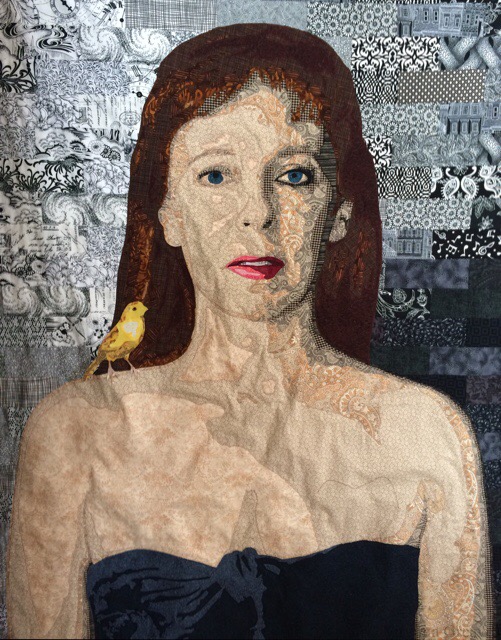
So here’s my second try — much better. I also added some white highlights in the iris of the eyes.
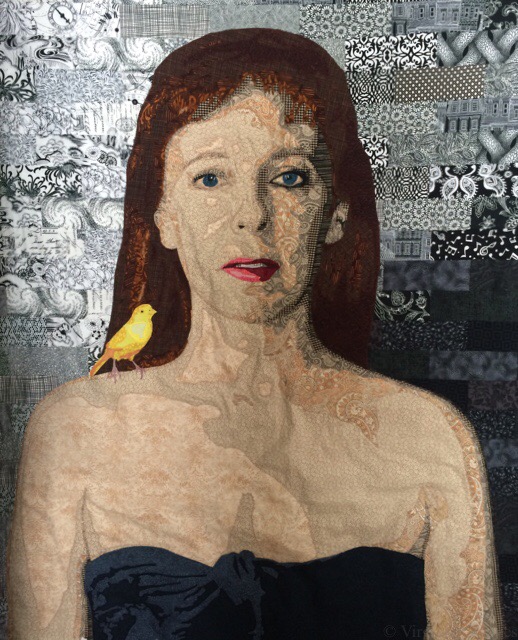
Then I decided that I wanted her to be wrapped with vines, so I cut 1/4 strips of a green fabric on the bias and ironed them on in waves.
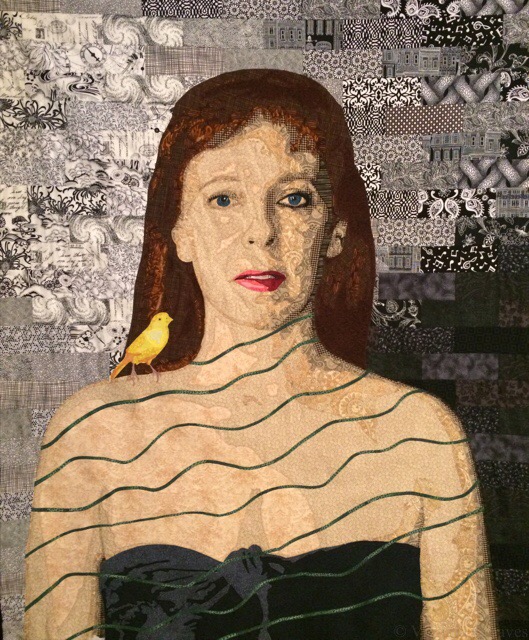
After appliquéing them down, they looked too plain, so I decided to embroider thorns on the vines.
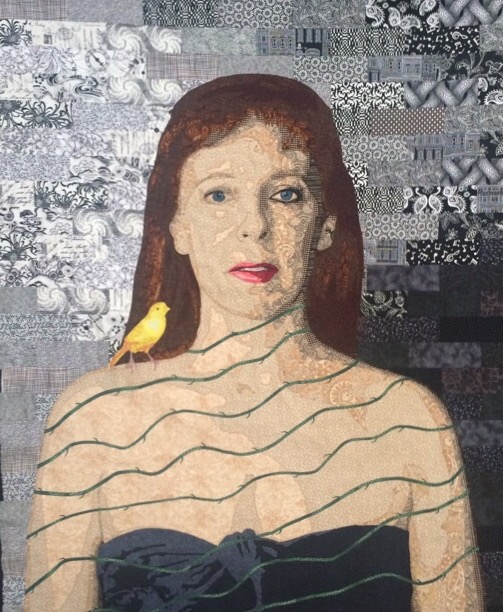
And at this point, it’s just not quite right. The left eye is too plain compared to the right eye. So I added darker fabric and some black embroidery around the left eye. It’s the light side of the face, but it has to balance the right.
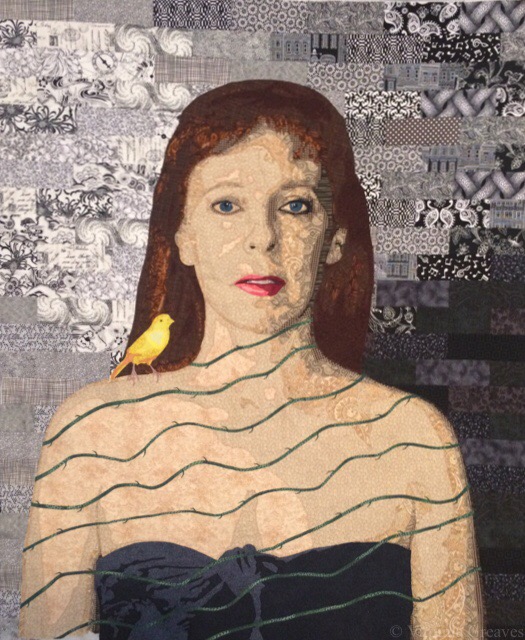
Subtle, but I think it makes a difference.
Did I think of Frida Kahlo’s self-portrait with thorns when I did this? At some point, I did. But this is my interpretation. Me and my canary.
She’s basted now and ready for quilting. The deadline for the exhibit I’m entering her in is still over a month away, but I have a lot to get done between now and then. The first week of March, the Wash & Wax exhibit will be hung at Jacksonville State University, and Leisa Rich and I are making 5 more Microbubbles (small framed pieces) and one more large piece — a triptych.

2015 IQA Auction
1Everyone is getting ready to go to Houston next week, and it makes me sad that I won’t be there. I’ve been there the last two years — but I didn’t have anything new to enter. All of the work I’ve made in the last 18 months has gone into the Wash & Wax exhibit. It was at Abernathy in Sandy Springs, GA through October 18th. Four of the pieces will hang in a private gallery in Buckhead, GA in January. The entire exhibit will show at Hammond Gallery at Jacksonville State University in Jacksonville, AL in March, and then an abbreviated version of the show will travel to TX in the summer.
Where have I been lately? In the melee of curating Formidable Fibers and finishing up Wash & Wax, I fell and broke my right wrist, which is my dominant hand, on Labor Day. I was given a removable cast and told only to take it off to shower. When the cast came off a couple of weeks ago, the wrist was 80% healed, but I had lost 50% mobility. The good news is that I’ve become fairly ambidextrous. The bad news is that typing really hurts. Even now after some physical therapy. So baby steps.
But since everyone is going to Houston next week, I wanted to share the one piece I did make and send — a piece for the IQA Auction. (I did, by the way, complete this just before breaking my wrist.)
I spent a while contemplating what to do. I was close to completing everything for Wash & Wax, but I had started an entry for a SAQA show whose deadline is October 31. I considered making a complete face, but I didn’t really have time to do it justice. However, they asked for something in our signature style, so I felt as if I should do something along the lines of a portrait. Last year I did a cardinal. Small format work is hard for me.
I finally decided that I could do a set of eyes peeking through a slot in a door — rather like the woman peeking through Amy Pond’s reality in Doctor Who. This is the first two skin values.
This is the third. Still hard to see without the irises of the eyes for reference.
Four and five give enough definition, but he still looks rather like a zombie.
The last value gives you the exaggerated curve of the questioning eyebrows.
And finally, the eyes. For inspiration, I used a picture I took of my husband soon after we were married. I even managed to match his eye color fairly well.
And here he is peeking through the door.
I changed how I did this face — subtly, but I like how it turned out. I usually don’t start any part of the eyes until the end. In this instance, I filled in the whites of the eyeballs in the beginning when I laid down the other lightest values in the face. It makes then recede a little bit more.
So if you get a chance, stop by the Auction Booth at IQA while you’re in Houston next week and make a bid on one of the fabulous pieces they’ll have. And if someone would snap a quick pic of mine on the wall with the other work and then email it to me, I’d be very grateful.

Abstract #5 Comes Together
0All of my studio time nowadays is dedicated to completing the projects for the two-person show I’m collaborating on with Leisa Rich to be debuted in October. Last week, while she was working on #4, I drafted #5 and started cutting it out.
Leisa asked me to go big on this one — so that is what I did. I went to the limits of what I could currently handle in my studio for this kind of project — 48″ x 60″. I had to have a surface large enough to fuse the shapes onto my canvas. Since my table wasn’t large enough, I ended up laying one of my design walls flat on the floor — it was exactly 48″ wide.
And for the pattern, for the first time in years, I used the services of a blueprint company and a vector program. My copy of CorelDraw was woefully out of date, and I don’t have a PC anymore, so I ended up purchasing iDraw which worked perfectly for my purposes. (Even after 15 or so years, my Wacom Graphire 4 tablet continues to be a workhorse for me.) I created the pattern and emailed it to the local shop. I did spend some time talking to them about what I wanted though because a print of this size can cost upwards of $80. I had it printed out on inexpensive paper on their 36″ wide printer and then taped the two pieces together (the final cost was under $10).
I also had to buy some rather large pieces of red fabric for this. I didn’t have anything in my stash nearly large enough.
Here you see it with all the yellows, blues, and dark purples.
And here you see the beginnings of the red.
Lots and lots of red. For this particular value, I had to buy 2 yards, and the largest piece still had to be spliced in one place because it was wider than 42″ (the width of the fabric).
And this is the final piece. I don’t know that my iPhone did the best job in the world, but it’s fine for an in-process shot. I think that this one is the most evocative of the car wash theme that we’ve done so far.
To be honest, I was surprised at the huge leap between value 4 and 5 — and that 6 didn’t stand out very well against value 5– but after cutting out almost 2 yards of value 5, I wasn’t willing to start over. It still accomplishes what I wanted it to. There is a lot of room for Leisa to go wild on the embroidery — can’t wait to see what she does with this one.
The last time we met, she gave me some more pieces to work on for the large wall piece, and I still have #4 to quilt. Lots to do.

Studio Frenzy
0Last week, I finished cutting the 4th abstract in the Car Wash series that I’m working on with Leisa Rich.
Like my other pieces, I approached it with the intent of cutting it out in color order starting with the yellows, then the purples, then the blues — but as I went on, the entire thing became unwieldy. Breaking it down into meaningful pieces became really hard. I became best friends with my colored highlighters — and I bought more of them. I rued the day that I had drafted this thing. I think I may have pulled some hair out.
I ended up with all of my fabrics on the cutting board and the master pattern on top of the piece I was constructing.
This was my first picture.
I started working on the blues at the bottom, then adding in the grays.
Then I started working on the top but was coming to the realization that the only way I could approach this monster was to finish whole sections as I came to them.
This is just insanity. I did realize that I was almost out of that medium gray and I was going to need more. I was very pragmatic about it, though. I put all of the gray that I did have along the outer edges. Then I planned a search mission to the fabric store and luckily found something in the same color and value. It has a lot more texture, but I think that that’s fine.
Here, I can see the light at the end of the tunnel. Literally, everything is done but the part in the very middle. At this point, I highlighted that section in the middle on my pattern so I’d know where I was. I kept getting lost.
And here it is before I gave it to Leisa — a quick shot on my wall before I whisked it away. She is embroidering it. So many edges.
On my new time keeping app, I can easily see how much time I’ve spent doing something. I spent 39 1/2 hours cutting this out. Holy cow.
So my next piece is going to be much simpler. It has to be. I have at least 4 more large pieces to do for the show and I want to have them completed by the end of May.
Since I handed this last abstract piece off to Leisa, I’ve been working on the abstract piece that will cover the largest wall in the gallery. It will be made up of a lot of smaller pieces that will be hung individually. Leisa is making the tops of these pieces — and she gave me a bunch to work on. I pillowcase turned them — no easy feat — topstitched them, and am now adding some quilting. They’re meant to be very textural on the wall so they aren’t heavy with quilting. I’ll share some pics later.
I also wanted to share this picture of my daughter in the Dominican Republic. She went after Christmas on a mission trip with her school and her father.
I let her take my camera — my DSLR Canon T3i. I was looking forward to seeing all of the pictures of the DR, but alas, the only pictures I will see are the ones they took with their cell phones. This is the last known sighting of my camera — it was stolen at the airport on her return trip home.
It made me very sad, but I have all ready replaced it. The camera body came last week — and I’m waiting on the lens. It should be here today or tomorrow. Instead of the 18-55mm kit lens, this time I opted for the “nifty fifty” — the prime 50mm lens. It has no image stabilization or zoom — but it’s “faster glass” with an f-stop of 1.8 compare to the f-stop of 3.5-5.6 on the kit lens. It’s a less expensive lens, but I’m told that it’s a far superior lens. Can’t wait for it to get here!

Working with Paper Backed Fusible
0Last week, I drove up to Blairsville, GA to talk to the Misty Mountain Quilter’s Guild just before Thanksgiving. It was a wonderful group, and even though my wireless connection from the iPad to the projector decided not to work, we made do with the quilts that I had brought and still had a memorable time. I love telling stories about my work and inspiring other quilters to push themselves — to see the possibilities of what they can do with determination in their hearts.
I am always surprised at how many people ask me about how I use fusible in my work. It would be tough to do what I do without fusible. Deidre Scherer free-hand cuts all of her pieces, pins them down, and then machine embroiders them to completion. I marvel at her ability to do this. I typically have everything drawn out in advance, and if adjustments have to be made to the paper copy, I use a pencil to make sure I get it right before I ink it.
For those of you familiar with paper backed fusible, this short tutorial will not be interesting — but for those that are curious or just want to see how I work, I made a couple of small pieces to demonstrate the most basic principles.
First I start with a drawing. For this piece, I drew a square with my ruler and then two conjoining circles with the top of my spray starch can. The circles are considered primary to the square in this pattern — which means that the circles are intended to sit above the square in comparative space.
Each shape is numbered 1,2,3 — these are my value numbers. 1 is always the lightest.
This is the 1st version and the easiest to do because the square is on the bottom and the darker circles are on top. I <almost> always work from light to dark. If you work from dark to light, you run the risk of the darker fabrics showing through the edges of the lighter fabrics.
The first thing you do is trace out your shapes onto paper backed fusible. I use Wonder Under. Trace the shape onto the smooth paper side and then roughly cut out around the shape — just outside the drawn line.
You should always use the reverse of your pattern as the template for your fusible templates. I forgot to do this — but in this particular instance, it won’t matter (It does in the 2nd version — so you may notice that I just left both of the final fused pieces in reverse.)
And by the way, reversing a pattern is easy; simply trace over the shapes with an ultra fine point Sharpie. All of the marks will transfer to the back of the paper. Then you use the back of the pattern for tracing your Wonder Under shapes.
Fuse your templates onto the BACK of your fabric with the iron on a cotton setting. (This is a batik so the back is the same as the front.) Roughly cut out around the shape.
Cut directly on the line you have drawn.
Score the back of the paper with something sharp like a pin.
Then you can rip the paper off the back of the fabric. The fusible should stay on the back of the fabric. If it sticks to the paper, re-iron the paper back down with a hotter iron and when cool, re-score and rip the paper off.
Prepare a backing fabric to fuse to. You could fuse directly to an appliqué pressing sheet. This is a special plastic sheet to which you can fuse and then later peel off and use as a large appliqué later. I do this sometimes, especially with large and complex pieces.
Fuse down the lightest value first. For this template, it’s the square in the middle. Use your iron on the setting BELOW cotton, the one for polyester. If you leave the iron on the cotton setting, you will eventually bake the fused fabric to the point that it will not stick.
Fusibles are temporary. They need to hold long enough for you to stitch over them to hold them more permanently. In complex designs, you will find that things start to move as you scrunch everything around and under the needle, but re-ironing will re-stick them where you want them to stay — for a while. Over-ironing with an iron that is too hot, however, can burn the fusible away and there will be a lot more movement. So although it is difficult to iron the fusible onto the fabric with the cotton and then bring the heat down to fuse the shapes onto the final appliqué, it is worthwhile to remember if at all possible.
Then fuse the next darker circle — and then the next darker circle.

And it’s finished.
This is the 2nd version which is more difficult because the darkest fabric is in the middle with the lighter fabrics in the two corner circles. Remember that we want to keep the circles primary even though they will be fused before the square.
The two circles are traced onto fusible — but the area that will overlap with the square now has an extra lip added so that it will slip under the square. If this extra wasn’t added, then the background fabric might show in the space between the circles and square. That happens at times and is easily covered with thread, but it should be the exception, not the rule, or you’ll be spending a lot of time covering things that are much more easily handled at this point in the process.
Also note that the square is now no longer a square. If we fuse the 3rd value down last, if we cut out an entire square, then the circles would no longer be on top (which is our goal — for them to be primary).
First fuse the lightest value circle and then fuse the 2nd value. Make certain that the overlap flaps will fall under the “square” shape.

And then add the “square” shape in the darkest value. Since the circles are primary, the square is set behind them. Notice that the square shape covers the flaps that were created on the circle shapes.
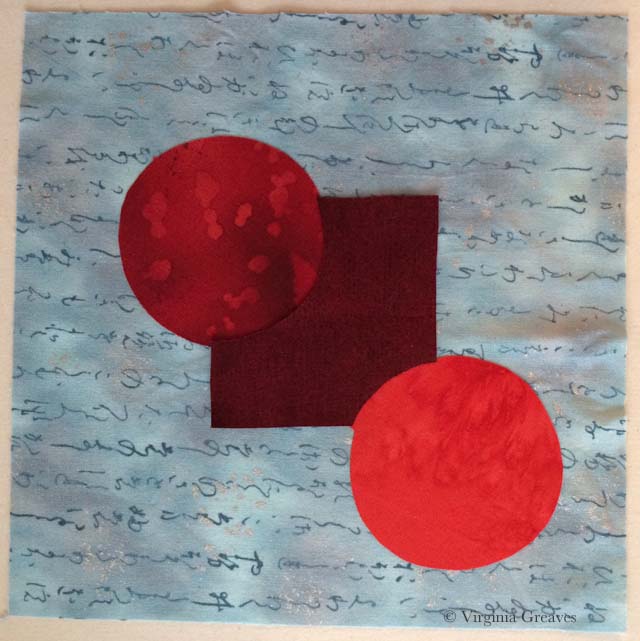
These are the two designs. The one on the right is the first template. The one on the left is the second template. They are identical in final form, but by moving the values, we have changed the construction.
Hopefully this explains the process in its most basic forms. Understanding how values affect how you cut your shapes is essential to working with a paper backed fusible. I always start with my lightest values and work to my darkest values.
The exception to this are the teeth in faces. They never look right done this way. I always make them from dark to light — but the overall pieces are small enough and the pieces are light enough in value that color shadowing isn’t an issue.

Having a Good Hair Day
0Before I left for Houston, I had made some good progress on the hair in this portrait. I always find it hard to leave in the middle of a project, but I had finished most of the hair.
In this pic, here is only one small part of the first value in the part — in the top at the middle. Then the next value is golden.
Although I really wanted to go with brown purples, I just didn’t have them in my stash and I couldn’t find them in the store nearby, so I ended up going from golden into an orange brown — which is really more of a realistic choice for this model’s actual hair.
The next value shows the brown. (I somehow managed to lose one of the highlights in her right eye — didn’t notice it until her hair was done.)
And this shows the darkest browns.
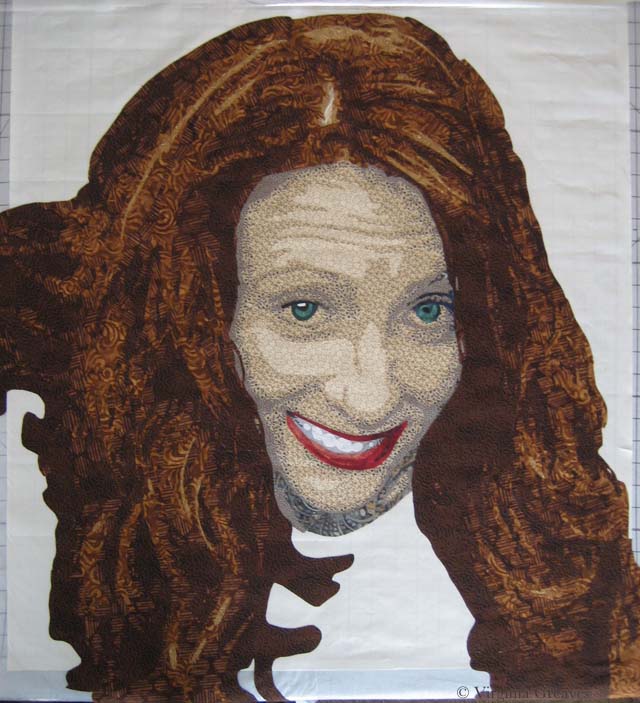
Then I laid in all the blacks, which included her shirt, and the little bit of gray.
I spent of lot time trying to find a perfect background. I had bought several greens, but in the end, they fell flat. A purple seemed like a striking choice, but I didn’t have anything that worked well. I had a blue that I liked, but I’ve used it as a background before, so I went to the store with the mission of finding one similar. This batik has some deeper shadows that I like. It sets her hair off nicely. I took this pic with my iPhone which makes her hair look more red than it is.
I also replaced the highlight in the right eye and put more gray in her right arm. I had it all brown which was just wrong and caused by blurred lines between her hair and her shirt.
This week, I added the background and started the appliqué. Her face is done and I’m about halfway done with her hair. I hope to start quilting her soon. The days are clicking by quickly and my deadline approaches.

Building Character in a Face
3I have been busy cutting away here recently. This is my favorite part — cutting and fusing. It’s meditative and yet the puzzle is still challenging.
I do have to say, however, that my decision to choose different colors has resulted in an even greater sense of realism than I have had before. Because of this, presenting the face in layers feels more odd than ever before. By the time the face is fully shown at the end of this post, without hair, it feels like looking at a naked face. It’s a little unsettling.
I also confess that, after taking several pictures of my model, I chose not to go with one that you would choose to go on your mantle. I think this is a more playful picture that shows her personality better. She’s actually looking up a little at the viewer.
This is the first layer. I’ve learned the hard way not to go any lighter than this.
And this is the second value. I know that my model is screaming at me right now. I promised not to show any wrinkles. The truth is that because she is looking up into the camera, there are lines of personality here. They seem stark in this picture, but bear with me. In the end, especially once all of the hair is fused on, they will only add to her character and will not be seen as age lines.
Here is the third value. It’s always important to remember that eyes are set INTO our faces so even if the picture doesn’t give us darker values around the eyes, it’s best to put it there for our rendering to give a sense of depth.
Here is the fourth value. I was surprised that this stony gray worked so well in this gradation.
This is the sixth value. There isn’t much of it here.
This is the seventh value. It’s actually a deep navy blue.
The eighth value is black which is mostly in the neck. I’ll revisit that in a minute.
These are her lovely green eyes. You can begin to see her peeking out of the fabric.
And these are her teeth. They don’t make a lot of sense yet without her lips. These are the only pieces that I put on in reverse order — dark to light.
And here she is with her mouth. She looks a little stark without her hair — but I’m working on that now.
At this point, I step back and think about how this will work with what I have to do next. Her neck is too dark given that her shirt will be black, so I decide to pull the values back and re-do the neck.
Here they are re-done. You see a lot more of value six, which I prefer, but you still get the sense of the jawline and the recession of the neck.
Hopefully I’ll finish her hair before I leave for Houston next week.

























